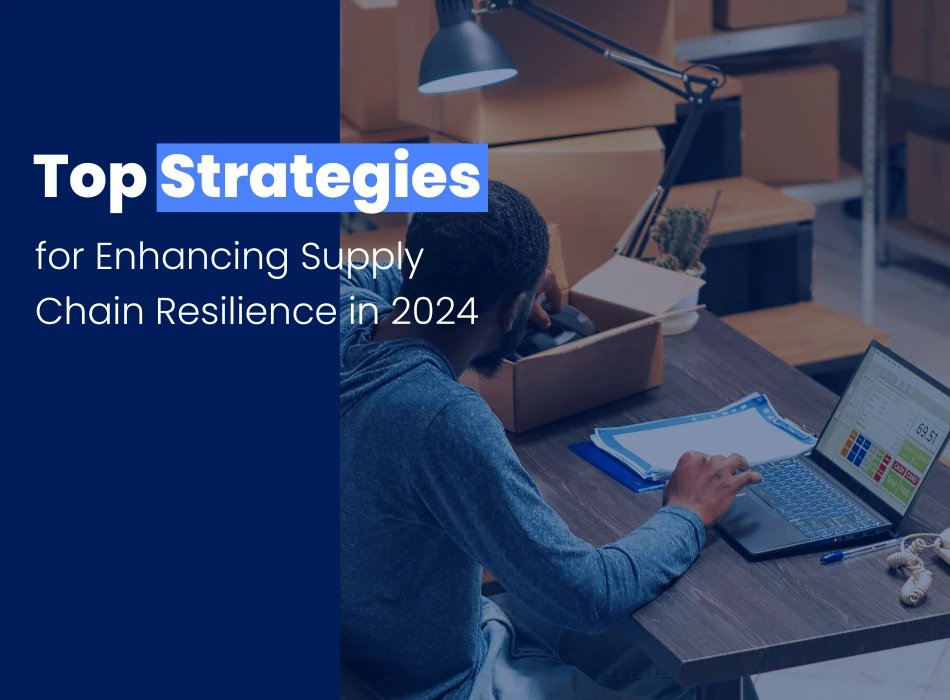Top Strategies for Enhancing Supply Chain Resilience in 2024
Explore top strategies for enhancing supply chain resilience in 2024, including supplier diversification, real-time visibility, inventory optimization, collaboration, technology adoption, and sustainability initiatives.

As global supply chains face increasing disruptions—from geopolitical tensions to climate change—building resilience has become a critical focus for businesses. Here are the top strategies that companies can implement to enhance their supply chain resilience in 2024.
Diversification of Suppliers
Key Insight: Reducing dependency on a single source of supply is essential for mitigating risks associated with disruptions.
- Implementation: Companies should collaborate with multiple suppliers across different regions or countries. This strategy not only spreads risk but also ensures that operations can continue smoothly even if one supplier faces challenges. For example, businesses can adopt dual sourcing for critical components, creating redundancy in their supply chain.
Supply Chain Mapping and Visibility
Key Insight: Achieving visibility across the entire supply chain is crucial for identifying vulnerabilities and proactively managing risks.
- Implementation: Utilize advanced technologies such as blockchain, IoT, and data analytics to provide real-time insights into supply chain operations. Mapping the end-to-end supply chain helps identify critical nodes and develop contingency plans. Companies like DHL are leveraging these technologies to enhance operational visibility.
Inventory Optimization
Key Insight: Balancing inventory levels with service levels is vital for maintaining efficiency while preparing for disruptions.
- Implementation: Adopt inventory optimization techniques such as just-in-time inventory management, demand forecasting, and safety stock planning. This approach allows businesses to buffer against disruptions while minimizing carrying costs. For instance, companies can implement predictive analytics to better forecast demand and adjust inventory accordingly.
Collaboration and Partnerships
Key Insight: Strong relationships with suppliers, customers, and logistics providers foster trust and enable rapid response during disruptions.
- Implementation: Establish collaborative ecosystems where information, resources, and best practices are shared among partners. Engaging in regular communication and joint problem-solving can significantly enhance resilience. Companies like Unilever prioritize collaboration with suppliers to ensure smoother operations.
Agile and Adaptive Operations
Key Insight: Flexibility is key to navigating through supply chain disruptions.
- Implementation: Adopt agile operations strategies that allow for quick decision-making and response to changing market dynamics. This may involve redesigning processes, implementing modular production systems, and investing in cross-training employees to perform multiple roles. Firms like Procter & Gamble have adopted agile methodologies to adapt quickly to market changes.
Scenario Planning and Risk Assessment
Key Insight: Conducting scenario planning exercises helps businesses anticipate potential disruptions and develop proactive mitigation strategies.
- Implementation: Regularly perform risk assessments covering all aspects of the supply chain. Identify potential disruptions and their impact on operations. For example, companies can simulate various scenarios to evaluate their effects on supply chain performance, allowing them to prioritize risk mitigation efforts effectively.
Embracing Technology for Real-Time Data
Key Insight: Real-time data is essential for informed decision-making and effective risk management.
- Implementation: Invest in state-of-the-art monitoring tools that offer predictive analytics. Technologies such as IoT devices and cloud-based systems ensure a continuous flow of real-time data across the supply chain. Companies like Amazon utilize advanced data analytics to optimize their logistics operations.
Strengthening Supplier Relationships
Key Insight: Building strong partnerships with suppliers enhances transparency and trust within the supply chain.
- Implementation: Engage in strategic sourcing that prioritizes reliability over cost. Establish clear communication channels with suppliers to foster collaboration and mutual understanding of capabilities and constraints. This approach helps create a resilient supplier network that can withstand disruptions.
Developing Contingency Plans
Key Insight: Preparedness is crucial for managing unexpected events effectively.
- Implementation: Create comprehensive contingency plans that outline specific actions to take during various disruption scenarios. This includes establishing alternative routes, backup suppliers, and emergency logistics partners to ensure continuity during crises.
Focus on Sustainability
Key Insight: Sustainable practices not only benefit the environment but also enhance resilience by reducing risks associated with resource scarcity.
- Implementation: Prioritize sustainable sourcing, ethical labor practices, and environmental stewardship in supply chain operations. Companies like Walmart are actively working on sustainability initiatives that contribute to long-term resilience while meeting consumer expectations for responsible business practices.
Conclusion
Enhancing supply chain resilience is imperative for businesses aiming to thrive amid uncertainty in 2024. By adopting these strategies—diversifying suppliers, improving visibility, optimizing inventory, fostering collaboration, embracing technology, strengthening supplier relationships, developing contingency plans, and focusing on sustainability—companies can better prepare for disruptions while ensuring continuity of operations.
As global supply chains evolve, staying proactive in building resilience will be essential for maintaining competitiveness in an increasingly complex landscape.